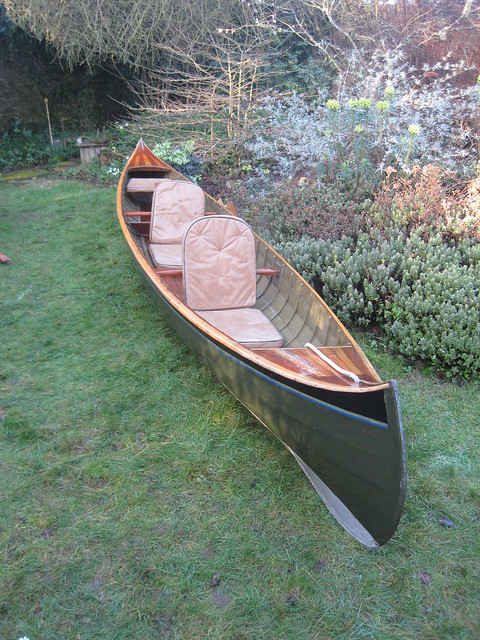samb
Wooden Canoe Maniac
I have a clinker built/lapstrake canoe. It is of some age and built with 6 mahogany planks each side – 5 at about 3”x ¼” and a wider one at the keel. I understand that in an ideal world, clinker boats are best kept wet but this cannot happen. Most of the time it will be stored at home, outside but covered so in the shade and paddled just a few times each year. Although I’ve worked on, built and restored most other types of wooden canoe, this is the first clinker built canoe to come into my hands.
 IMG_3824 by sambrowning, on Flickr
IMG_3824 by sambrowning, on Flickr
Before the other day, the boat last saw water sometime in the ‘90s and some of the planks have splits. Whether they were there in the past and the swollen wood kept water out I don’t know, but now I’m told, it’s like a sieve. Because the boat will never get more than about 5 hours wetting at a time, it will never get time to ‘take-up’ so I’ll need to do something with these splits. At present the boat is painted, so I can’t really see, but none of the splits appear to be open. Most reading suggests cleaning out the splits and then epoxy fill (G-Flex), but others say this could make things worse.
My question is - if I got the boat dry (about 6mths before I can start on it, kept outside and under cover), I clean out and epoxy the splits, tighten the rivets if necessary, cover all with multiple coats of varnish, then, if I have it on the water for maybe 5 hours each month, will the mahogany swell around the epoxy causing the wood to split further or will I be ok? Advice, opinions and comments (about the boat) are welcome.
Thanks
Sam
 IMG_3824 by sambrowning, on Flickr
IMG_3824 by sambrowning, on FlickrBefore the other day, the boat last saw water sometime in the ‘90s and some of the planks have splits. Whether they were there in the past and the swollen wood kept water out I don’t know, but now I’m told, it’s like a sieve. Because the boat will never get more than about 5 hours wetting at a time, it will never get time to ‘take-up’ so I’ll need to do something with these splits. At present the boat is painted, so I can’t really see, but none of the splits appear to be open. Most reading suggests cleaning out the splits and then epoxy fill (G-Flex), but others say this could make things worse.
My question is - if I got the boat dry (about 6mths before I can start on it, kept outside and under cover), I clean out and epoxy the splits, tighten the rivets if necessary, cover all with multiple coats of varnish, then, if I have it on the water for maybe 5 hours each month, will the mahogany swell around the epoxy causing the wood to split further or will I be ok? Advice, opinions and comments (about the boat) are welcome.
Thanks
Sam





